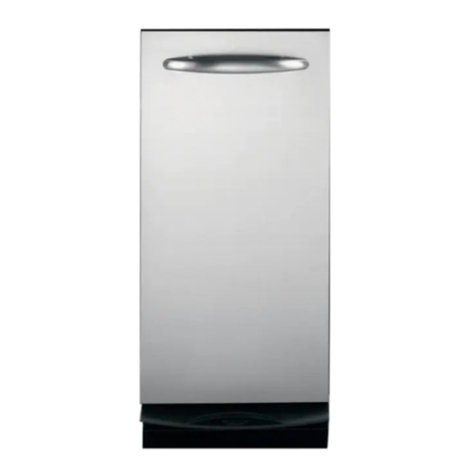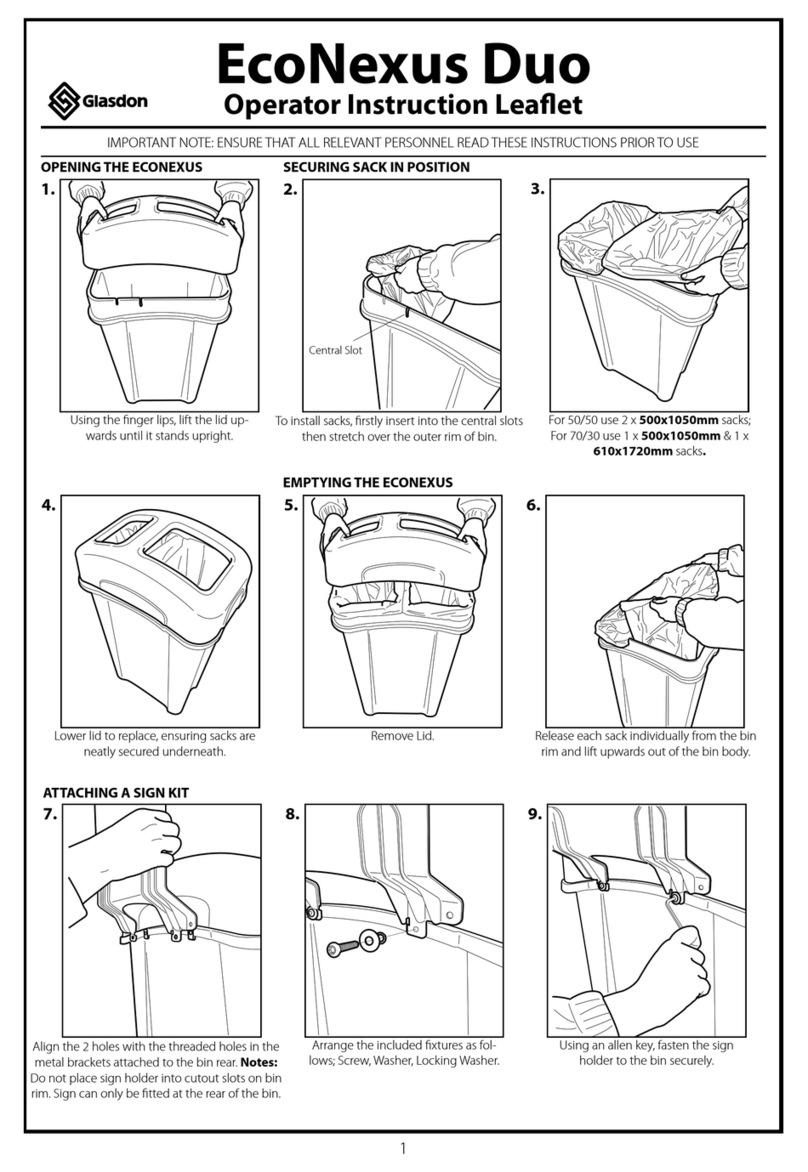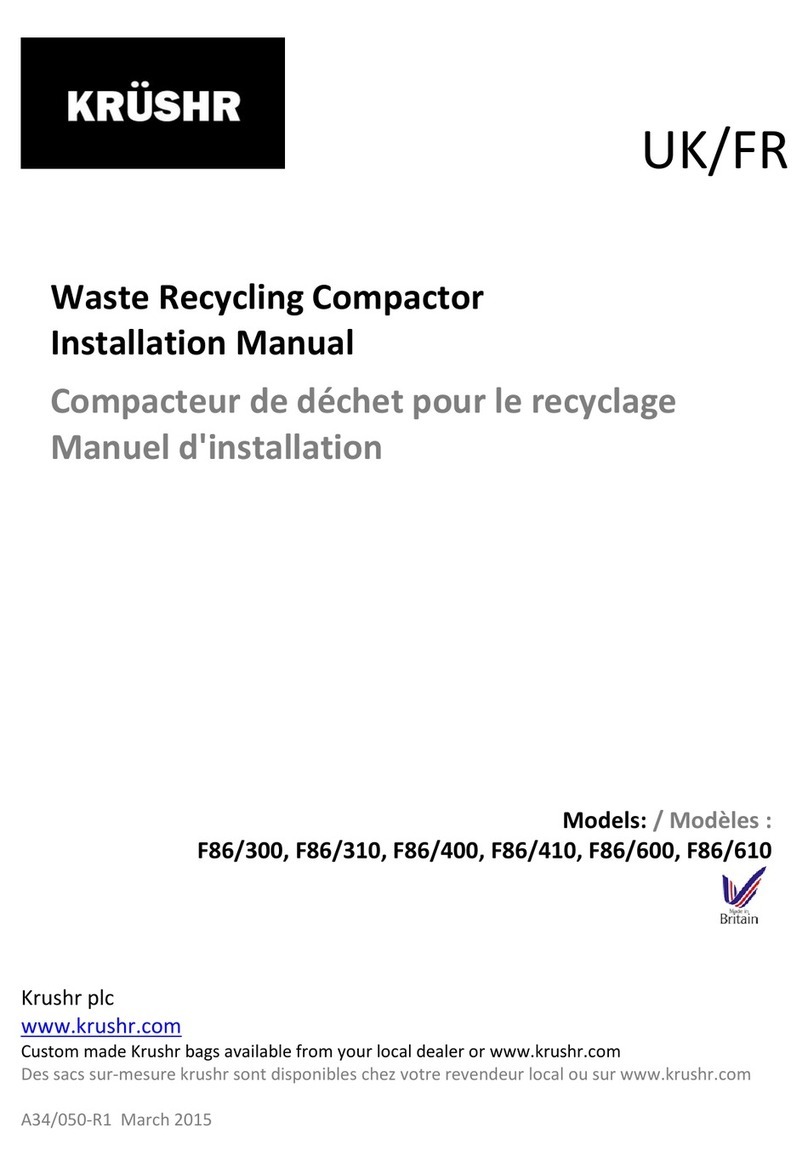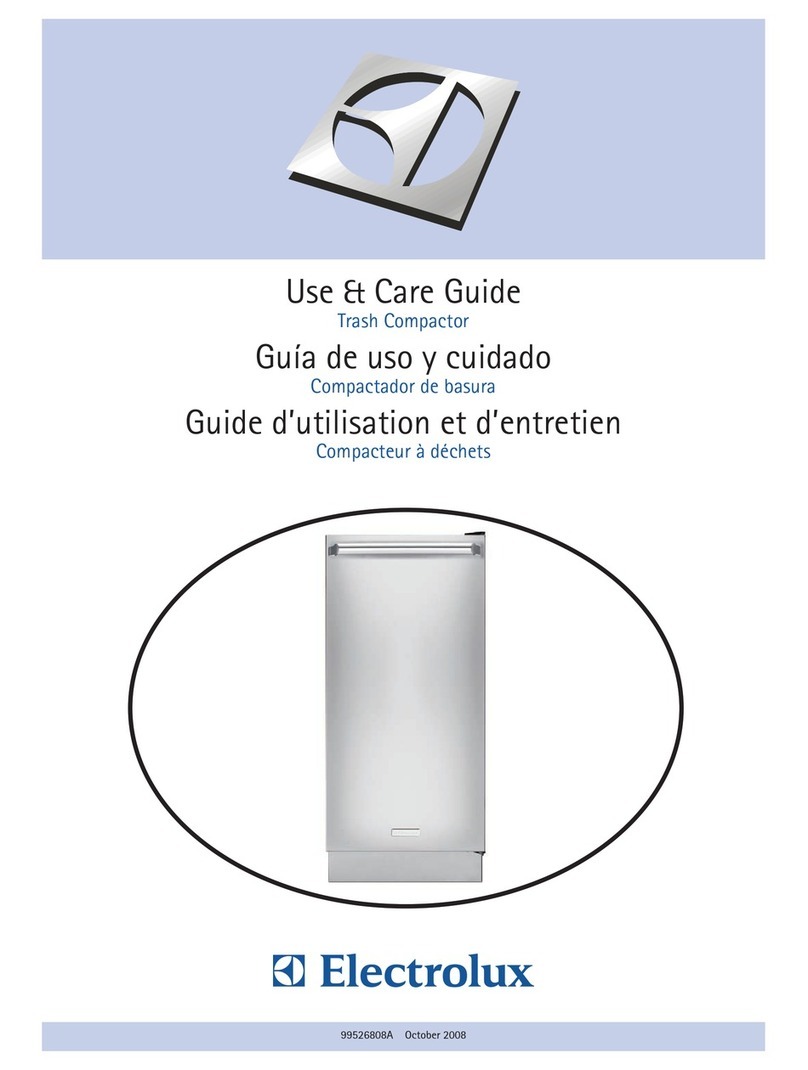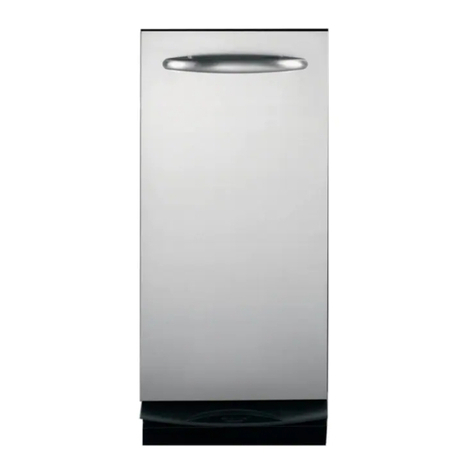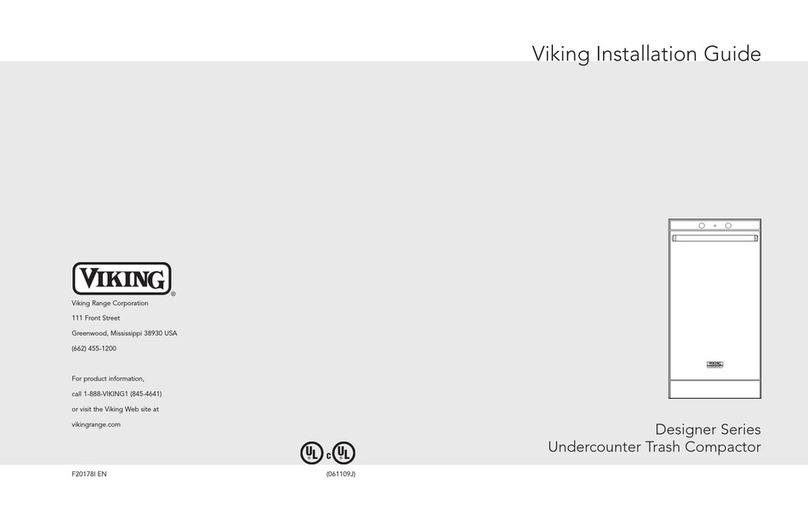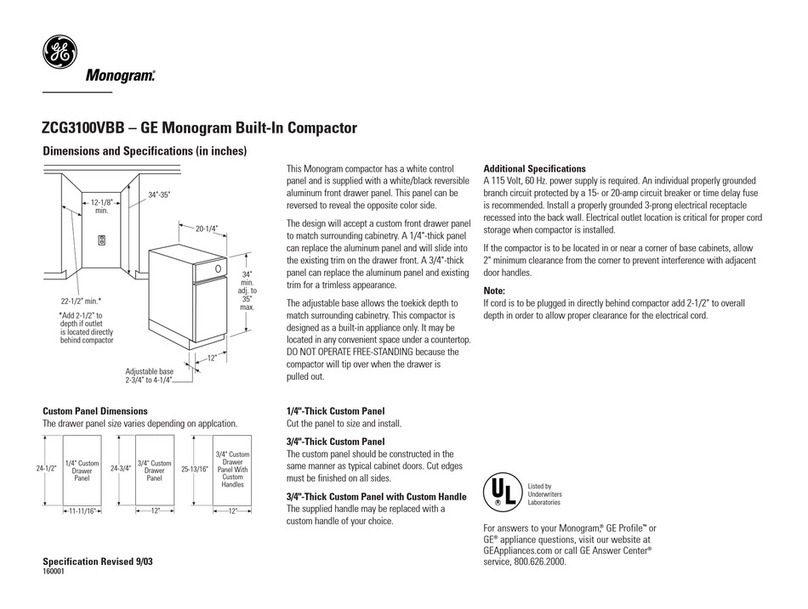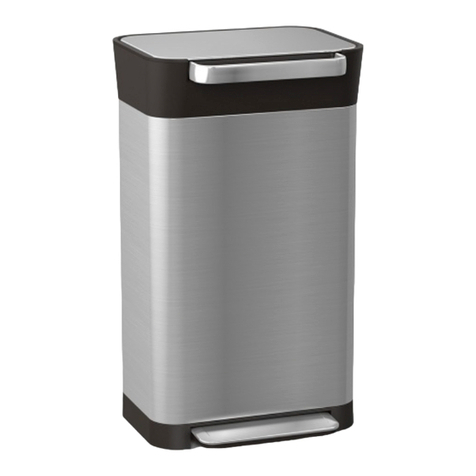Century UL 1086 User manual

UL 1086
ISBN 1-55989-928-X
Household Trash Compactors


Underwriters Laboratories Inc. (UL)
333 Pfingsten Road
Northbrook, IL 60062-2096
UL Standard for Safety for Household Trash Compactors,UL 1086
Fourth Edition, Dated February 1, 1996
Revisions: This Standard contains revisions through and including January 6, 2004.
SUMMARY OF TOPICS
The revisions dated January 6, 2004 were issued to incorporate the following new and revised
requirements:
• Revisions To Change
″
Natural Gray
″
To
″
Gray
″
For Identification Of Grounded
Conductors
• Addition Of Marking Requirements For HP Ratings Not Less Than The Equivalent HP
Ratings Of Combined Loads
UL Standards for Safety are developed and maintained in the Standard Generalized Markup Language
(SGML). SGML -- an international standard (ISO 8879-1986) -- is a descriptive markup language that
describes a document’s structure and purpose, rather than its physical appearance on a page. Due to
formatting differences resulting from the use of UL’s new electronic publishing system, please note that
additional pages (on which no requirements have been changed) may be included in revision pages due
to relocation of existing text and reformatting of the Standard.
Text that has been changed in any manner is marked with a vertical line in the margin. Changes in
requirements are marked with a vertical line in the margin and are followed by an effective date note
indicating the date of publication or the date on which the changed requirement becomes effective.
The following table lists the future effective dates with the corresponding item.
Future Effective Date References
January 6, 2005 48.3
The new and/or revised requirements are substantially in accordance with UL’s Bulletin(s) on this subject
dated October 1, 2003. The bulletin(s) is now obsolete and may be discarded.
The revisions dated January 6, 2004 include a reprinted title page (page1) for this Standard.
As indicated on the title page (page 1), this UL Standard for Safety is an American National Standard.
Attention is directed to the note on the title page of this Standard outlining the procedures to be followed
to retain the approved text of this ANSI/UL Standard.
As indicated on the title page (page1), this UL Standard for Safety has been adopted by the Department
of Defense.
JANUARY 6, 2004 − UL 1086 tr1

The master for this Standard at UL’s Northbrook Office is the official document insofar as it relates to a
UL service and the compliance of a product with respect to the requirements for that product and service,
or if there are questions regarding the accuracy of this Standard.
UL’s Standards for Safety are copyrighted by UL. Neither a printed copy of a Standard, nor the distribution
diskette for a Standard-on-Diskette and the file for the Standard on the distribution diskette should be
altered in any way. All of UL’s Standards and all copyrights, ownerships, and rights regarding those
Standards shall remain the sole and exclusive property of UL.
All rights reserved. No part of this publication may be reproduced, stored in a retrieval system, or
transmitted in any form by any means, electronic, mechanical photocopying, recording, or otherwise
without prior permission of UL.
Revisions of UL Standards for Safety are issued from time to time. A UL Standard for Safety is current
only if it incorporates the most recently adopted revisions.
UL provides this Standard ″as is″without warranty of any kind, either expressed or implied, including but
not limited to, the implied warranties of merchantability or fitness for any purpose.
In no event will UL be liable for any special, incidental, consequential, indirect or similar damages,
including loss of profits, lost savings, loss of data, or any other damages arising out of the use of or the
inability to use this Standard, even if UL or an authorized UL representative has been advised of the
possibility of such damage. In no event shall UL’s liability for any damage ever exceed the price paid for
this Standard, regardless of the form of the claim.
UL will attempt to answer support requests concerning electronic versions of its Standards. However, this
support service is offered on a reasonable efforts basis only, and UL may not be able to resolve every
support request. UL supports the electronic versions of its Standards only if they are used under the
conditions and operating systems for which it is intended. UL’s support policies may change from
time-to-time without notification.
UL reserves the right to change the format, presentation, file types and formats, delivery methods and
formats, and the like of both its printed and electronic Standards without prior notice.
Purchasers of the electronic versions of UL’s Standards for Safety agree to defend, indemnify, and hold
UL harmless from and against any loss, expense, liability, damage, claim, or judgement (including
reasonable attorney’s fees) resulting from any error or deviation introduced while purchaser is storing an
electronic Standard on the purchaser’s computer system.
If a single-user version electronic Standard was purchased, one copy of this Standard may be stored on
the hard disk of a single personal computer, or on a single LAN file-server or the permanent storage
device of a multiple-user computer in such a manner that this Standard may only be accessed by one user
at a time and for which there is no possibility of multiple concurrent access.
If a multiple-user version electronic Standard was purchased, one copy of the Standard may be stored on
a single LAN file-server, or on the permanent storage device of a multiple-user computer, or on an Intranet
server. The number of concurrent users shall not exceed the number of users authorized.
Electronic Standards are intended for on-line use, such as for viewing the requirements of a Standard,
conducting a word search, and the like. Only one copy of the Standard may be printed from each
single-user version of an electronic Standard. Only one copy of the Standard may be printed for each
JANUARY 6, 2004 − UL 1086tr2

authorized user of a multiple-user version of an electronic Standard. Because of differences in the
computer/software/printer setup used by UL and those of electronic Standards purchasers, the printed
copy obtained by a purchaser may not look exactly like the on-line screen view or the printed Standard.
An employee of an organization purchasing a UL Standard can make a copy of the page or pages being
viewed for their own fair and/or practical internal use.
The requirements in this Standard are now in effect, except for those paragraphs, sections, tables, figures,
and/or other elements of the Standard having future effective dates as indicated in the note following the
affected item. The prior text for requirements that have been revised and that have a future effective date
are located after the Standard, and are preceded by a ″SUPERSEDED REQUIREMENTS″notice.
New product submittals made prior to a specified future effective date will be judged under all of the
requirements in this Standard including those requirements with a specified future effective date, unless
the applicant specifically requests that the product be judged under the current requirements. However, if
the applicant elects this option, it should be noted that compliance with all the requirements in this
Standard will be required as a condition of continued Listing and Follow-Up Services after the effective
date, and understanding of this should be signified in writing.
Copyright © 2004 Underwriters Laboratories Inc.
This Standard consists of pages dated as shown in the following checklist:
Page Date
1-2B ..........................................................................January 6, 2004
3...........................................................................December 1, 1999
4 ............................................................................February 1, 1996
5..........................................................................December 17, 1998
6-8...........................................................................February 1, 1996
9..........................................................................December 17, 1998
10............................................................................January 6, 2004
10A-10B ...................................................................December 17, 1998
11-18B ........................................................................January 6, 2004
19.........................................................................December 17, 1998
20-20B......................................................................December 1, 1999
21-22B ........................................................................January 6, 2004
23-36 ........................................................................February 1, 1996
37-38B ........................................................................January 6, 2004
39-45 ........................................................................February 1, 1996
46.........................................................................December 17, 1998
47-48B......................................................................December 1, 1999
49-50 ........................................................................February 1, 1996
51-52B ........................................................................January 6, 2004
53-54 ........................................................................February 1, 1996
55-56 .........................................................................January 6, 2004
A1-A2.........................................................................January 6, 2004
JANUARY 6, 2004 − UL 1086 tr3

JANUARY 6, 2004 − UL 1086tr4
No Text on This Page

FEBRUARY 1, 1996
(Title Page Reprinted: January 6, 2004)
1
UL 1086
Standard for Household Trash Compactors
First Edition – September, 1976
Second Edition – February, 1979
Third Edition – December, 1991
Fourth Edition
February 1, 1996
The most recent designation of ANSI/UL 1086 as an American National Standard
(ANSI) occurred on December 8, 2003. The ANSI approval for this standard does
not include the Cover page, Transmittal Pages, Title Page, Foreword, or
Appendix A.
This ANSI/UL Standard for Safety, which consists of the Fourth Edition with
revisions through January 6, 2004, is under continuous maintenance, whereby
each revision is ANSI approved upon publication. Comments or proposals for
revisions on any part of the Standard may be submitted to UL at any time. Written
comments are to be sent to the UL Northbrook Standards Department, 333
Pfingsten Road, Northbrook, IL 60062.
An effective date included as a note immediately following certain requirements
is one established by Underwriters Laboratories Inc.
The Department of Defense (DoD) has adopted UL 1086 on August 12, 1994.
The publication of revised pages or a new edition of this Standard will not
invalidate the DoD adoption.
Revisions of this Standard will be made by issuing revised or additional pages
bearing their date of issue. A UL Standard is current only if it incorporates the
most recently adopted revisions, all of which are itemized on the transmittal notice
that accompanies the latest set of revised requirements.
ISBN 1-55989-928-X
COPYRIGHT © 1976, 2004 UNDERWRITERS LABORATORIES INC.
ANSI/UL 1086-2003

JANUARY 6, 2004HOUSEHOLD TRASH COMPACTORS - UL 10862
No Text on This Page

CONTENTS
FOREWORD ................................................................................4
INTRODUCTION
1 Scope ...............................................................................5
2 Glossary .............................................................................5
3 General ..............................................................................5
3.1 Components ...................................................................5
3.2 Units of measurement ...........................................................6
3.3 References ....................................................................6
4 Field-Attached Accessories .............................................................6
CONSTRUCTION
5 General ..............................................................................6
6 Frame and Enclosure ..................................................................7
7 Accessibility of Uninsulated Live Parts and Film-Coated Wire ............................10A
8 Overload-Protective Devices ..........................................................15
9 Mechanical Assembly ................................................................16
10 Protection Against Corrosion .........................................................16
11 Power-Supply Connections ..........................................................17
11.1 Cord-connected appliances ....................................................17
11.2 Permanently connected appliances .............................................20
12 Live Parts ..........................................................................22
13 Internal Wiring ....................................................................22A
14 Electrical Insulation .................................................................24
15 Acoustical and Thermal Insulation ....................................................25
16 Motors .............................................................................25
17 Switches ...........................................................................26
18 Capacitors .........................................................................27
19 Lampholders .......................................................................27
20 Grounding .........................................................................28
21 Double Insulation ...................................................................29
22 Spacings ..........................................................................29
PROTECTION AGAINST RISK OF INJURY TO PERSONS
23 Scope .............................................................................31
24 General ............................................................................31
25 Sharp Edges .......................................................................31
26 Compacting Space ..................................................................31
27 Enclosure and Guards ...............................................................32
28 Interlocks and Controls ..............................................................33
28.1 Controls .....................................................................33
28.2 Interlocks ....................................................................33
29 Temperatures ......................................................................34
30 Stability ............................................................................34
31 Aerosol Containers and Deodorizers ..................................................35
JANUARY 6, 2004 HOUSEHOLD TRASH COMPACTORS - UL 1086 2A

PERFORMANCE
32 General ............................................................................35
33 Leakage Current Test ...............................................................35
34 Continuity Test of Grounding Circuit ...................................................38
35 Current Input Test .................................................................38A
36 Starting Current Test ................................................................39
37 Temperature Test ...................................................................39
38 Dielectric Voltage-Withstand Test .....................................................43
39 Moisture Resistance Test ............................................................44
39.1 Humidity ....................................................................44
39.2 Water spillage ...............................................................44
40 Tests on Supply Cords ..............................................................45
40.1 Flexing ......................................................................45
40.2 Strain relief ..................................................................46
40.3 Push-back relief ..............................................................46
41 Overload Test on Switches ..........................................................46
42 Tests on Liquid Containers ...........................................................47
43 Burnout Test on Components ........................................................47
43.1 General .....................................................................47
43.2 Electrolytic capacitor ..........................................................48
44 Leakage Test for Capacitors .........................................................48
45 Permanence of Marking Test .........................................................48
MANUFACTURING AND PRODUCTION TESTS
46 Dielectric Voltage-Withstand Test ....................................................48A
47 Grounding Continuity ................................................................50
RATING
48 General ............................................................................50
MARKING
49 General ............................................................................51
INSTRUCTION MANUAL
50 General ............................................................................53
51 Instructions Pertaining to a Risk of Fire, Electric Shock, or Injury to Persons ...............53
52 Grounding Instructions ..............................................................55
53 Use-Maintenance Instructions ........................................................56
APPENDIX A
Standards for Components..............................................................A1
JANUARY 6, 2004HOUSEHOLD TRASH COMPACTORS - UL 10862B

DECEMBER 1, 1999 HOUSEHOLD TRASH COMPACTORS - UL 1086 3
No Text on This Page

FOREWORD
A. This Standard contains basic requirements for products covered by Underwriters Laboratories Inc. (UL)
under its Follow-Up Service for this category within the limitations given below and in the Scope section
of this Standard. These requirements are based upon sound engineering principles, research, records of
tests and field experience, and an appreciation of the problems of manufacture, installation, and use
derived from consultation with and information obtained from manufacturers, users, inspection authorities,
and others having specialized experience. They are subject to revision as further experience and
investigation may show is necessary or desirable.
B. The observance of the requirements of this Standard by a manufacturer is one of the conditions of the
continued coverage of the manufacturer’s product.
C. A product which complies with the text of this Standard will not necessarily be judged to comply with
the Standard if, when examined and tested, it is found to have other features which impair the level of
safety contemplated by these requirements.
D. A product employing materials or having forms of construction which conflict with specific requirements
of the Standard cannot be judged to comply with the Standard. A product employing materials or having
forms of construction not addressed by this Standard may be examined and tested according to the intent
of the requirements and, if found to meet the intent of this Standard, may be judged to comply with the
Standard.
E. UL, in performing its functions in accordance with its objectives, does not assume or undertake to
discharge any responsibility of the manufacturer or any other party. The opinions and findings of UL
represent its professional judgment given with due consideration to the necessary limitations of practical
operation and state of the art at the time the Standard is processed. UL shall not be responsible to anyone
for the use of or reliance upon this Standard by anyone. UL shall not incur any obligation or liability for
damages, including consequential damages, arising out of or in connection with the use, interpretation of,
or reliance upon this Standard.
F. Many tests required by the Standards of UL are inherently hazardous and adequate safeguards for
personnel and property shall be employed in conducting such tests.
FEBRUARY 1, 1996HOUSEHOLD TRASH COMPACTORS - UL 10864

INTRODUCTION
1 Scope
1.1 These requirements cover trash compactors that are rated 250 volts or less and intended for
household use to reduce the volume of waste prior to disposal; and that are intended to be employed in
accordance with the National Electrical Code, NFPA 70.
1.2 A product that contains features, characteristics, components, materials, or systems new or different
from those covered by the requirements in this Standard, and that involves a risk of fire, electric shock, or
injury to persons shall be evaluated using the appropriate additional component and end-product
requirements to determine that the level of safety as originally anticipated by the intent of this Standard is
maintained. A product whose features, characteristics, components, materials, or systems conflict with
specific requirements or provisions of this Standard shall not be judged to comply with this Standard.
Where appropriate, revision of requirements shall be proposed and adopted in conformance with the
methods employed for development, revision, and implementation of this Standard.
1.2 revised December 17, 1998
2 Glossary
2.1 For the purpose of this standard the following definitions apply.
2.2 CONVERTIBLE APPLIANCE – A free-standing or portable appliance that is intended to be converted
to an undercounter or recessed appliance.
2.3 FREESTANDING APPLIANCE – An appliance that is not intended for attachment to the building
structure or to adjacent cabinets or appliances.
2.4 PORTABLE APPLIANCE – A cord-connected appliance mounted on wheels, casters, or the
equivalent, and intended to be moved about.
2.5 RECESSED APPLIANCE – An appliance that is intended for installation and use with the rear and
both sides located adjacent to cabinets, walls, or other appliances. A recessed appliance may be such as
to permit location under a countertop.
2.6 UNDERCOUNTER APPLIANCE – An appliance intended for installation under a countertop, and for
attachment to the building structure or to adjacent cabinets, walls, or appliances.
3 General
3.1 Components
3.1.1 A component used with an appliance covered by this standard shall comply with the standard or
other requirements for the component. See Appendix A for a list of standards covering components
generally used in the products covered by this standard.
Exception: A component need not comply with a specific requirement that:
a) Involves a feature or characteristic not needed in the application of the component in the
product covered by this standard.
b) Is superseded by a requirement in this standard.
DECEMBER 17, 1998 HOUSEHOLD TRASH COMPACTORS - UL 1086 5

3.1.2 A component shall be used in accordance with its recognized rating established for the intended
conditions of use.
3.1.3 Specific components are recognized as being incomplete in construction features or restricted in
performance capabilities. Such components are intended for use only under limited conditions, such as
certain temperatures not exceeding specified limits, and shall be used only under those specific conditions
for which they have been recognized.
3.2 Units of measurement
3.2.1 If a value for measurement as given in these requirements is followed by an equivalent value in
other units, in parentheses, the second value may be only approximate. The first stated value is the
requirement.
3.3 References
3.3.1 In the following text, a requirement that applies only to a specific type of trash compactor is so
identified by a specific reference in that requirement to the type involved. Absence of such specific
reference or use of the term appliance indicates that the requirement applies to all trash compactors
covered by this standard unless the context indicates otherwise.
3.3.2 Any undated reference to a code or standard appearing in the requirements of this standard shall
be interpreted as referring to the latest edition of that code or standard.
4 Field-Attached Accessories
4.1 The requirements in 4.2 – 4.6 apply to accessories intended for installation on or connected to an
appliance for the purpose of modifying or supplementing the functions of the appliance or accessory.
4.2 An appliance having provision for the use of accessories to be attached in the field shall be
constructed so that the use of these accessories will not introduce a risk of fire, electric shock, or injury
to persons.
4.3 Acceptable receptacles and plug-in connectors shall be provided for the installation of an accessory
intended to be installed by the operator.
4.4 Terminals in an appliance and wire connectors are an acceptable means for the installation of an
accessory intended to be installed by qualified personnel.
4.5 An installation that necessitates field rearrangement of components or wiring, cutting or splicing of
wiring, or soldering of connections is not acceptable.
4.6 An accessory is to be tested and trial-installed to determine whether its installation is feasible,
whether the instructions are detailed and correct, and whether use of the accessory introduces a risk of
fire, electric shock, or injury to persons.
CONSTRUCTION
5 General
5.1 An appliance shall employ materials that are acceptable for the use.
FEBRUARY 1, 1996HOUSEHOLD TRASH COMPACTORS - UL 10866

6 Frame and Enclosure
6.1 An appliance shall be formed and assembled so that it will have the strength and rigidity necessary
to resist the abuses to which it may be subjected, without increasing a risk of fire, electric shock, or injury
to persons due to total or partial collapse with resulting reduction of spacings, loosening or displacement
of parts, or other serious defects.
6.2 An appliance shall be provided with an enclosure of material acceptable for the application that shall
house all parts that may present a risk of fire, electric shock, or injury to persons under any condition of
use.
6.3 Among the factors to be taken into consideration when an enclosure is being judged are the:
a) Mechanical strength,
b) Resistance to impact,
c) Moisture-absorptive properties,
d) Combustibility,
e) Resistance to corrosion, and
f) Resistance to distortion at temperatures to which the enclosure may be subjected during
normal or abnormal use.
For a nonmetallic enclosure, all of these factors are to be considered with respect to thermal aging.
6.4 A cast- or sheet-metal section of an enclosure shall have a thickness not less than that specified in
Table 6.1.
Exception: An enclosure or part of an enclosure that complies with the requirements in 27.6 – 27.8.
6.5 Electrical parts of an appliance shall be located or enclosed so that protection against unintentional
contact with uninsulated live parts and internal wiring will be provided.
6.6 The enclosure of an appliance shall be such as to prevent molten metal, burning insulation, flaming
particles, or the like from falling on combustible materials, including the surface upon which the appliance
is supported and inside the compacting compartment.
FEBRUARY 1, 1996 HOUSEHOLD TRASH COMPACTORS - UL 1086 7

Table 6.1
Thickness of metal enclosure
Metal
Minimum thickness, inch (mm)
At small, flat unreinforced
surfaces and at surfaces of
a shape or size that
provides adequate
mechanical strength
At surfaces to which a
wiring system is to be
connected in the field At relatively large
unreinforced flat surfaces
Die-cast metal 3/64 (1.2) – 5/64 (2.0)
Cast malleable iron 1/16 (1.6) – 3/32 (2.4)
Other cast metal 3/32 (2.4) – 1/8 (3.2)
Uncoated sheet steel 0.026 (0.66) 0.032 (0.81) 0.026 (0.66)
Galvanized sheet steel 0.029 (0.74) 0.034 (0.86) 0.029 (0.74)
Nonferrous sheet metal other than
copper 0.036 (0.91) 0.045 (1.14) 0.036 (0.91)
Copper 0.033 (0.84) 0.043 (1.09) 0.033 (0.84)
6.7 The requirement in 6.6 necessitates that a switch, a relay, a solenoid, or the like, be completely and
individually enclosed except for terminals, unless it can be shown that breakdown of the component would
not result in a risk of fire, or unless there are no openings in the enclosure through which molten metal,
burning insulation, flaming particles, or the like, can fall. See 43.1.1 and 43.1.2. It will also necessitate the
use of a barrier of noncombustible material:
a) Under a motor unless:
1) The structural parts of the motor or of the appliance provide the equivalent of such a
barrier;
2) The protection provided with the motor is such that no burning insulation or molten
material falls to the surface that supports the appliance or into the compacting
compartment when the motor is energized under each of the following fault conditions:
i) Open main winding,
ii) Open auxiliary winding,
iii) Starting switch short-circuited, and
iv) Capacitor of a permanent-split-capacitor motor short-circuited and the rotor
locked – the short-circuit is to be applied before the motor is energized; or
FEBRUARY 1, 1996HOUSEHOLD TRASH COMPACTORS - UL 10868

3) The motor is provided with a thermal motor protector – a protective device that is
sensitive to temperature and current – that will prevent the temperature of the motor
windings from exceeding:
i) 125°C (257°F) when the motor is running at the maximum load at which it can
operate without causing the protector to cycle, and
ii) 150°C (302°F) with the rotor of the motor locked.
b) Under wire, unless its insulation is flame-retardant, such as neoprene- or thermoplastic-
insulated wires.
6.8 The barrier mentioned in 6.7 shall be horizontal, shall be located as illustrated in Figure 6.1, and shall
have an area in accordance with that illustration. Openings for drainage, ventilation, and the like, may be
employed in the barrier provided such openings would not permit molten metal, burning insulation, or the
like to fall on combustible material.
DECEMBER 17, 1998 HOUSEHOLD TRASH COMPACTORS - UL 1086 9

This is generated text for figtxt.
Figure 6.1
Location and extent of barrier
Figure 6.1 revised December 17, 1998
NOTES –
A – Region to be shielded by barrier. This will consist of the entire component if it is not otherwise shielded, and will consist of the
unshielded portion of a component which is partially shielded by the component enclosure or equivalent.
B – Projection of outline of component on horizontal plane.
C – Inclined line that traces out minimum area of barrier. When moving, the line is always:
1) tangent to the component,
2) 5 degrees from the vertical, and
3) so oriented that the area traced out on a horizontal plane is maximum.
D – Location (horizontal) and minimum area for barrier. The area is that included inside the line of intersection traced out by the
inclined line C and the horizontal plane of the barrier.
JANUARY 6, 2004HOUSEHOLD TRASH COMPACTORS - UL 108610

7 Accessibility of Uninsulated Live Parts and Film-Coated Wire
7.1 To reduce the likelihood of unintentional contact that may involve a risk of electric shock from an
uninsulated live part or film-coated wire, an opening in an enclosure shall comply with either (a) or (b).
a) For an opening that has a minor dimension (see 7.5) less than 1 inch (25.4 mm), such a part
or wire shall not be contacted by the probe illustrated in Figure 7.1.
b) For an opening that has a minor dimension of 1 inch or more, such a part or wire shall be
spaced from the opening as specified in Table 7.1.
Exception: A motor other than one used in a hand-supported portion of an appliance need not comply
with these requirements if it complies with the requirements in 7.2.
7.2 With respect to a part or wire as mentioned in 7.1, in an integral enclosure of a motor as mentioned
in the exception to 7.1:
a) An opening that has a minor dimension (see 7.5) less than 3/4-inch (19.1 mm) is acceptable
if:
1) Film-coated wire cannot be contacted by the probe illustrated in Figure 7.2;
2) In a directly accessible motor (see 7.6), an uninsulated live part cannot be contacted
by the probe illustrated in Figure 7.3; and
3) In an indirectly accessible motor (see 7.6), an uninsulated live part cannot be
contacted by the probe illustrated in Figure 7.4.
b) An opening that has a minor dimension of 3/4 inch or more is acceptable if a part or wire is
spaced from the opening as specified in Table 7.1.
7.3 The probes mentioned in 7.1 and 7.2 and illustrated in Figures 7.1 – 7.4 shall be applied to any depth
that the opening will permit, and shall be rotated or angled before, during, and after insertion through the
opening to any position that is necessary to examine the enclosure. The probes illustrated in Figures 7.1
and 7.3 shall be applied in any possible configuration; and, if necessary, the configuration shall be
changed after insertion through the opening.
DECEMBER 17, 1998 HOUSEHOLD TRASH COMPACTORS - UL 1086 10A

DECEMBER 17, 1998HOUSEHOLD TRASH COMPACTORS - UL 108610B
No Text on This Page
Table of contents
Popular Trash Compactor manuals by other brands
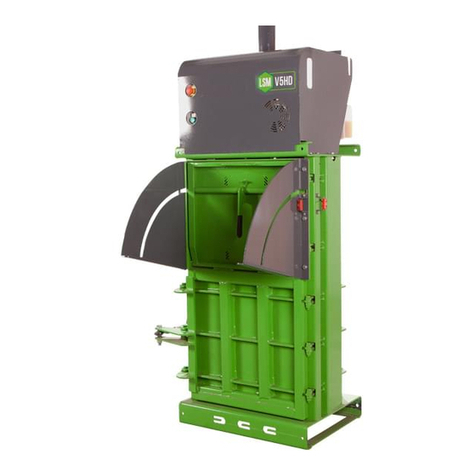
LSM
LSM V5HD Operator's instruction manual
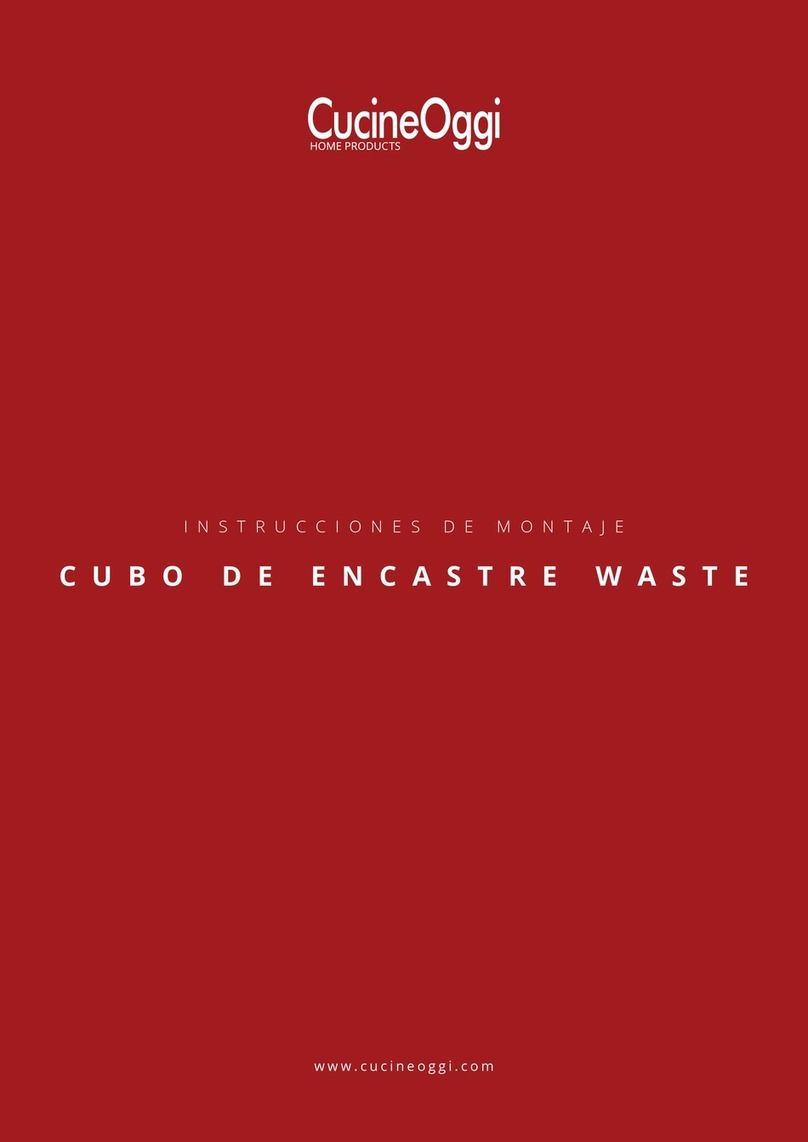
Cucine Oggi
Cucine Oggi Wesco Ergo-Master 060100-47 Assembly instructions

Broan
Broan Elite 15SSEXF Service manual

KitchenAid
KitchenAid KCCC151 manual
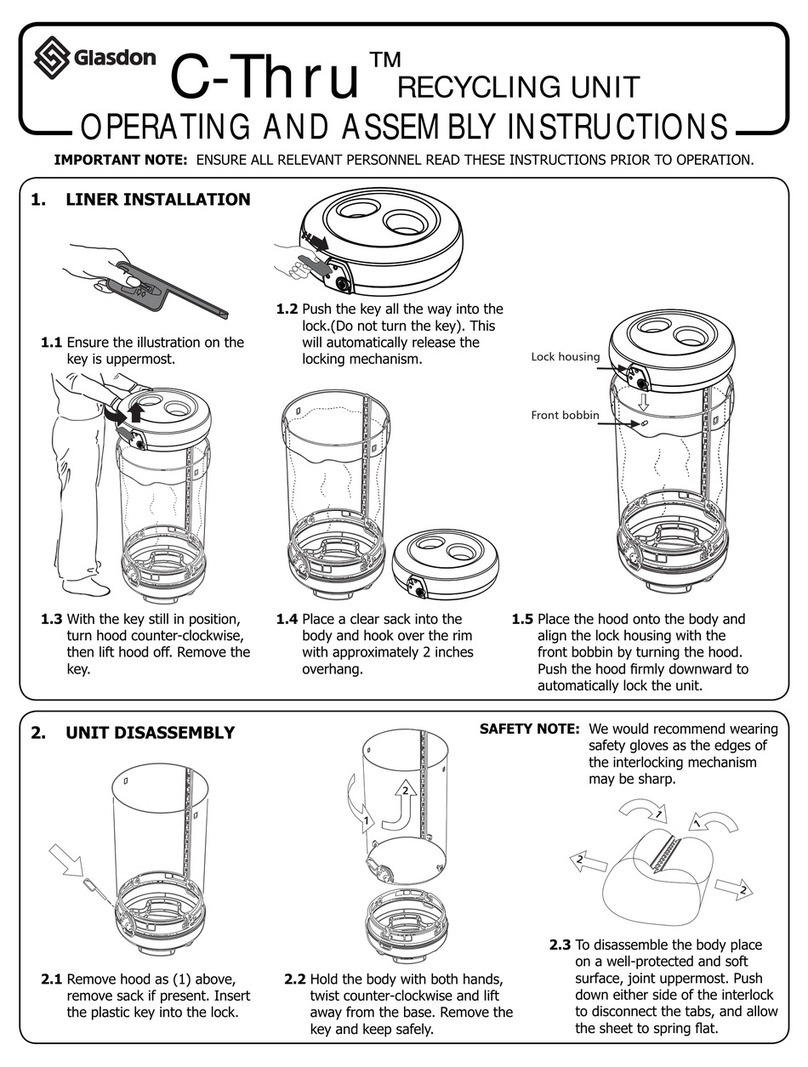
Glasdon
Glasdon C-Thru Operating and assembly instruction
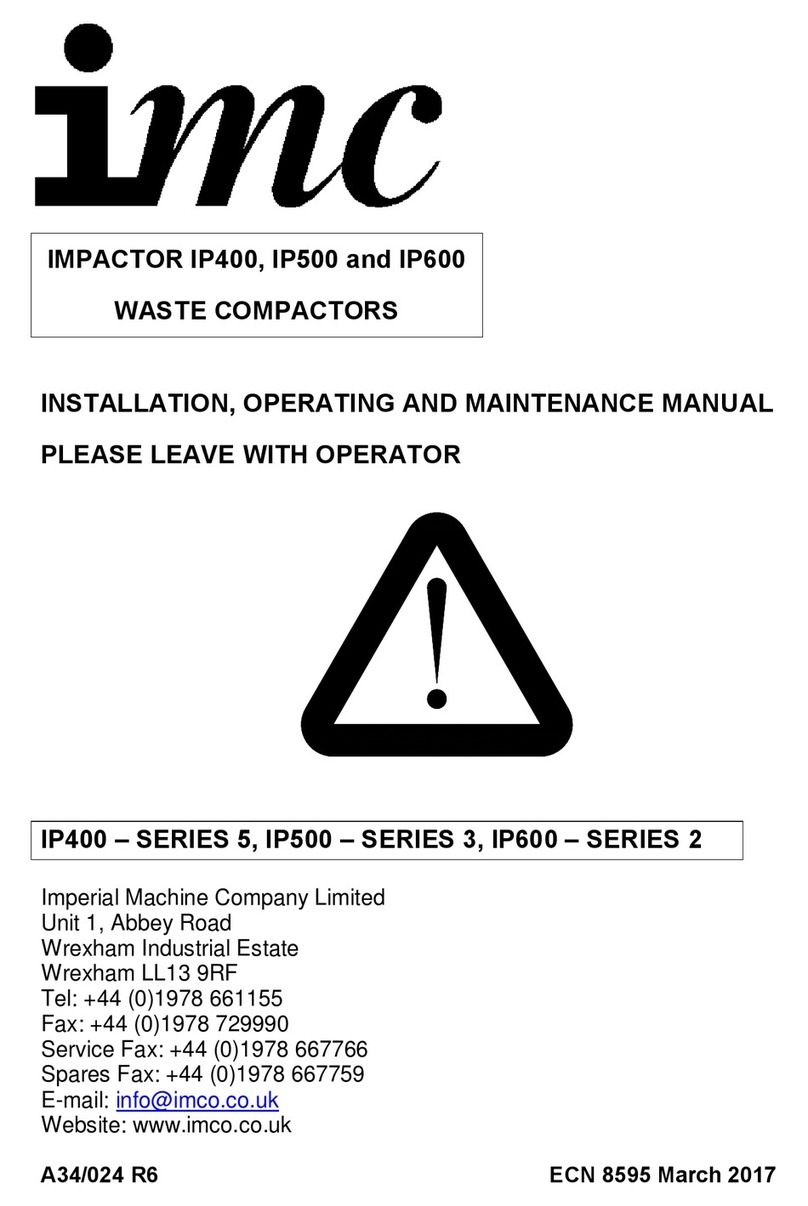
IMC
IMC 5 Series Installation, operating and maintenance manual
